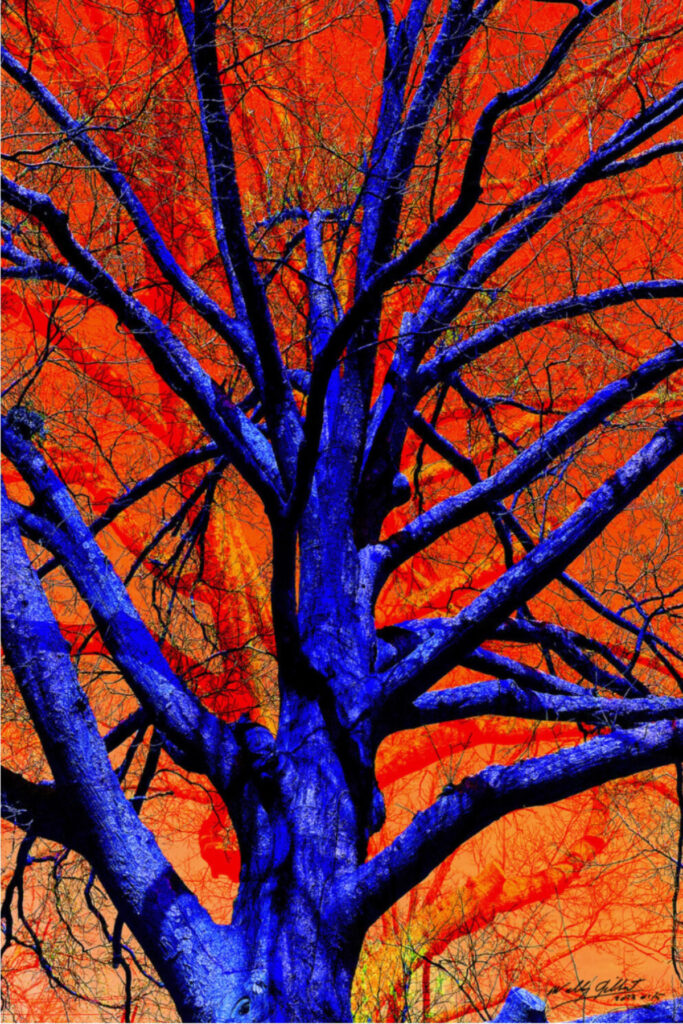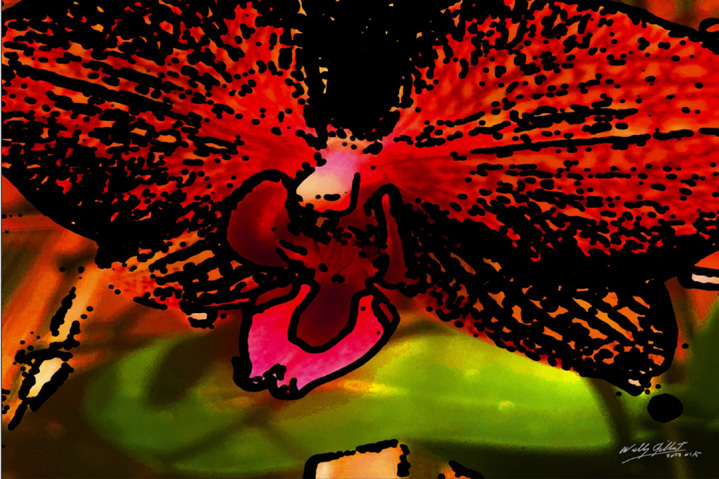
Wally Gilbert has been a photographer for much of his life. One of those real photographers who developed their own negatives, a skill that many professional photographers today have never experienced.
He was originally a journalistic photographer, recording the world, capturing landscapes, architecture, flora and fauna, people and much more. He became an early convert to digital photography around 2000, starting with a 2-megapixel camera and then discovered Photoshop which gave him the ability to add pixels and play with his images. This was the pivotal point at which Gilbert became more than a photographer, he became an artist.

“First came the pretty pictures, then they became fragments of the world, with a focus on the forms and colors. Then I started blowing up the images and distorting them.” Creativity was the new ingredient in his photography. He was no longer just a recorder.
At this point creativity itself was not new to Gilbert, having relied upon it for decades in the forefront of science, which led to his discovering the secrets of DNA sequencing for which he was awarded the Nobel Prize in Chemistry. “There is great commonality underlying my life as an artist and as a scientist. The underlying impulse in science is, can I find something new? Is there an idea that no-one else has yet discovered? Is there a fact about the world that nobody else knows yet. In art, the impulse is also about making something new.”

ChatGPT 3.5 (a form of A.I.) suggests that Creativity can be defined as the ability to combine or reorganize existing ideas, concepts or elements in a new and original way to produce something novel and valuable. It involves thinking “outside the box” and transcending established patterns of thought. These novel ideas are fueled in part by human curiosity, a trait that Gilbert has in abundance and which he uses to choreograph his work. His inspiration is curiosity. His underlying aim is to create original images of beauty, orchestrating shapes and colors on a 2-dimensional surface that resonate with the human psyche. He “uses the computer as an experimental tool…and twists the dials.” The results are Wally Gilbert’s art.
He often takes a photograph and then starts to play with the components of the image. At first, he would just add colors. Today he expands images, duplicates lines and shapes, and then adds colors until he finds the results satisfying. He enjoys using biological curves and playing with geometric forms. He has also created original digital designs, drawn from scratch on the computer.

He works with both representational images and abstract designs, moving between the two effortlessly and on a modulating scale. Some of his works are easily discernible. He has photographed graffiti on the streets, grease covered machines, buildings and doorways, sugary confections, ballerinas, matadors and wire cables.
At other times, he can greatly expand these photographs, zoom into the minutiae, repeat and juxtapose patterns, change the colors, distort scales and thereby birthing unique variations. In these cases, the results are so different that they appear to have no correlation to the original images at all, until that is, Gilbert explains his process for the viewer and shares his secrets. He is happy to be a tour guide through his artistic journey and his years of teaching allow him to easily keep his audience enthralled and animated. Vanishing started as a profile of a woman.
Duplicating and overlapping the outline manually, the image resulted in a clamshell-like black and white 3-dimensional design. Further adjusting colors and twisting the outlines resulted in the “Colorbands” series, which is totally different, and yet started with the same image as Vanishing. Similarly, a photograph of his wife’s black and white striped blouse morphed into the “Difference” and “Stripes series. His “Blue Tree” series on the other hand are easily identified as trees. Wings is obviously a flower, probably an orchid. They may be different, but all of Gilbert’s work has a central focus with an accompanying sense of movement, texture and undulating perspective that makes them mesmerizing.

How does he know when the creative manipulation, distortion, additions are done? When is the art complete? His answer is “choice.” Novelty does not make it art. It is the human element of choice that makes it art.
At his recent solo show “Patterns of Reality” at Viridian Artists in Chelsea, New York, viewers were overheard describing Gilbert’s work as spiritual and immersive and many were easily finding personal and intimate connections with his art. It can sometimes be difficult for abstract work to connect with a large and diverse audience and yet here, Wally Gilbert’s individual innovations of beauty and emotional satisfaction are hitting the mark. G&S
Viridian Artists Inc viridianartist.com – wallygilbert.artspan.com





Leave a Comment